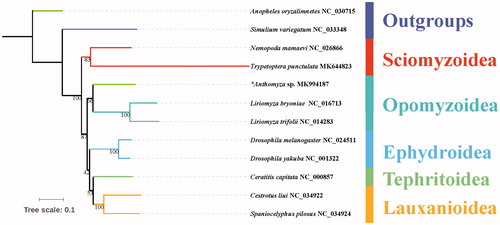Abstract
Anthomyza sp. belongs to family Anthomyzidae of superfamily Opomyzoidea. The mitogenome of Anthomyza sp. was sequenced as the first representative of the family. The mitogenome is 16,308 bp totally, consisting of 13 protein-coding genes, 2 rRNAs and 22 transfer RNAs and control region. Anthomyza sp. has the similar gene structures with other published species of Acalyptratae. The nucleotide composition biases toward A and T is 78.7% of the entirety. IQ-TREE analysis recovered the monophyly of Opomyzoidea, which is inferred from 12 species. It indicated that Opomyzoidea is assigned to be the sister of the clade of (Ephydroidea + (Tephritoidea + Lauxanioidea)).
Introduction
Anthomyzidae is a small Acalyptratae family comprised of 55 extant species assigned to 15 genera (Roháček Citation1998, Citation1999a, Citation1999b). Adults are distinctively slender and often found among low woodland or wetland vegetation (Marshall Citation2012). A few species have been found in nests of mice and moles, and in galls induced by the chloropid flies and mites. Only one species is known to develop on fungi (Ferrar Citation1987). Till now, the mitochondrial genome is not available in NCBI. Here, we sequenced mitochondrial genome of Anthomyza sp., the first representative of Anthomyzidae for further research.
The adult specimens of Anthomyza sp. (Accession number: ZCM2019-02) used for this study were collected from Zhonggusi, Xinglongxian, Hebei, China (E117.502313, N40.565317) by Qilemoge in June, 2018. The specimens were identified by Liang Wang. The specimens and DNA deposited in the Entomological Museum of China Agricultural University (CAU). The total genomic DNA was extracted from the whole body (except head) of the specimen using the QIAamp DNA Blood Mini Kit (Qiagen, Germany) and stored at −20 °C. The complete mitogenome of Anthomyza sp. is 16,308 bp. It encoded 13 PCGs, 22 tRNA, 2 rRNA genes and control region, and the structure is similar with related reports before (Wang et al. Citation2016; Li et al. Citation2017; Zhou et al. Citation2017; Yang et al. Citation2019). The nucleotide composition of the mitogenome was biased toward A and T, with 78.7% of A + T content (A = 39.9%, T = 38.8%, C = 12.6%, G = 8.6%). All PCGs in Anthomyza sp. utilize the conventional translational start codons for invertebrate mtDNA. For example, six PCGs (ATP6, COII, COIII, CYTB, ND4 and ND4L) initiated with ATG codons, five PCGs (ATP8, ND2, ND3, ND5 and ND6) initiated ATT codons, and ND1 initiated with ATA, COI initiated with TCG codons. Ten PCGs used the typical termination codons TAA; two PCGs (CYTB, ND5) used TAG and ND4 used T in Anthomyza sp.
Phylogenetic analysis was performed based on the nucleotide sequences of 13 PCGs from 12 Diptera species (Anopheles oryzalimnetes NC_030715, Simulium variegatum NC_033348, Nemopoda mamaevi NC_026866, Trypetoptera punctulata MK644823, Ceratitis capitata NC_000857, Cestrotus liui NC_034922, Spaniocelyphus pilosus NC_034924, Drosophila melanogaster NC_024511, Drosophila yakuba NC_001322, Liriomyza bryoniae NC_016713, Liriomyza trifolii NC_014283 and *Anthomyza sp. MK994187). IQ-TREE analysis () showed that the outgroups Anopheles oryzalimnetes and Simulium variegatum form a clade diverged from Acalyptratae clades. The Sciomyzoidea is monophyletic group that is similar with the pervious study (Yang et al. Citation2019). For the phylogeny of Opomyzoidea, the monophyletic relationship is recovered with the new mitogenomic data of Anthomyzidae. The Opomyzoidea is assigned to be the sister of the clade of (Ephydroidea + (Tephritoidea + Lauxanioidea)). The mitogenome of Anthomyza sp. could provide the important information for the further studies of Opomyzoidea phylogeny.
Disclosure statement
The authors report no conflicts of interest. The authors alone are responsible for the content and writing of the paper.
Additional information
Funding
References
- Ferrar P. 1987. A guide to the breeding habits and immature stages of Diptera Cyclorrhapha. Entomonograph. 8:1–907.
- Li X, Ding S, Li X, Hou P, Tang C, Yang D. 2017. The complete mitochondrial genome analysis of Eristalis tenax (Diptera, Syrphidae). Mitochondr DNA B. 2:654–655.
- Marshall SA. 2012. Flies: the natural history and diversity of Diptera. New York: Firefly Books Ltd.; p. 1‒616.
- Roháček J. 1998. Taxonomic limits, phylogeny and higher classification of Anthomyzidae (Diptera), with special regard to fossil record. Eur J Entomol. 95:141–177.
- Roháček J. 1999a. A revision and re-classification of the genus Paranthomyza Czerny, with description of a new genus of Anthomyzidae (Diptera). Stud Dipterol. 6:373–404.
- Roháček J. 1999b. Taxonomy and distribution of West Palaearctic Anthomyzidae (Diptera), with special regard to the Mediterranean and Macaronesian faunas. Bolletino Del Museo Regionale di Scienze Naturali di Torino. 16:189–224.
- Wang K, Wang Y, Yang D. 2016. The complete mitochondrial genome of a stonefly species, Togoperla sp. (Plecoptera: Perlidae). Mitochondr DNA A DNA Mapp Seq Anal. 27:1703–1704.
- Yang Q, Li X, Li Z, Pan Z, Yang D. 2019. The mitochondrial genome analysis of Trypetoptera punctulata (Diptera: Sciomyzidae). Mitochondr DNA B. 4:97–98.
- Zhou Q, Ding S, Li X, Zhang T, Yang D. 2017. Complete mitochondrial genome of Allognosta vagans (Diptera, Stratiomyidae). Mitochondr DNA B. 2:461–462.

